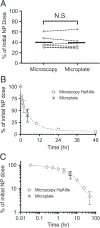Quantitative microscopy-based measurements of circulating nanoparticle concentration using microliter blood volumes
- PMID: 28412144
- PMCID: PMC7725539
- DOI: 10.1016/j.nano.2017.04.003
Quantitative microscopy-based measurements of circulating nanoparticle concentration using microliter blood volumes
Abstract
Nanoparticles (NPs) are potential drug delivery vehicles for treatment of a broad range of diseases. Intravenous (IV) administration, the most common form of delivery, is relatively non-invasive and provides (in theory) access throughout the circulatory system. However, in practice, many IV injected NPs are quickly eliminated by specialized phagocytes in the liver and spleen. Consequently, new materials have been developed with the capacity to significantly extend the circulating half-life of IV administered NPs. Unfortunately, current procedures for measuring circulation half-lives are often expensive, time consuming, and can require large blood volumes that are not compatible with mouse models of disease. Here we describe a simple and reliable procedure for measuring circulation half-life utilizing quantitative microscopy. This method requires only 2μL of blood and minimal sample preparation, yet provides robust quantitative results.
Keywords: Circulation half-life; Nanoparticles; Quantitative microscopy.
Copyright © 2017. Published by Elsevier Inc.
Figures



Similar articles
-
High-throughput quantitative microscopy-based half-life measurements of intravenously injected agents.Proc Natl Acad Sci U S A. 2020 Feb 18;117(7):3502-3508. doi: 10.1073/pnas.1915450117. Epub 2020 Feb 3. Proc Natl Acad Sci U S A. 2020. PMID: 32015123 Free PMC article.
-
Paclitaxel and quercetin nanoparticles co-loaded in microspheres to prolong retention time for pulmonary drug delivery.Int J Nanomedicine. 2017 Nov 13;12:8239-8255. doi: 10.2147/IJN.S147028. eCollection 2017. Int J Nanomedicine. 2017. PMID: 29180863 Free PMC article.
-
Docetaxel-loaded PLGA and PLGA-PEG nanoparticles for intravenous application: pharmacokinetics and biodistribution profile.Int J Nanomedicine. 2017 Jan 27;12:935-947. doi: 10.2147/IJN.S121881. eCollection 2017. Int J Nanomedicine. 2017. PMID: 28184163 Free PMC article.
-
Perfluorooctylbromide nanoparticles for ultrasound imaging and drug delivery.Int J Nanomedicine. 2018 May 25;13:3053-3067. doi: 10.2147/IJN.S164905. eCollection 2018. Int J Nanomedicine. 2018. PMID: 29872293 Free PMC article. Review.
-
Factors that control the circulation time of nanoparticles in blood: challenges, solutions and future prospects.Curr Pharm Des. 2010 Jul;16(21):2298-307. doi: 10.2174/138161210791920496. Curr Pharm Des. 2010. PMID: 20618151 Review.
Cited by
-
Ex vivo isolated human vessel perfusion system for the design and assessment of nanomedicines targeted to the endothelium.Bioeng Transl Med. 2020 Jan 28;5(2):e10154. doi: 10.1002/btm2.10154. eCollection 2020 May. Bioeng Transl Med. 2020. PMID: 32440561 Free PMC article.
-
High-throughput quantitative microscopy-based half-life measurements of intravenously injected agents.Proc Natl Acad Sci U S A. 2020 Feb 18;117(7):3502-3508. doi: 10.1073/pnas.1915450117. Epub 2020 Feb 3. Proc Natl Acad Sci U S A. 2020. PMID: 32015123 Free PMC article.
-
Compartmentalized ocular lymphatic system mediates eye-brain immunity.Nature. 2024 Apr;628(8006):204-211. doi: 10.1038/s41586-024-07130-8. Epub 2024 Feb 28. Nature. 2024. PMID: 38418880 Free PMC article.
-
Updating the modified Thompson test by using whole-body bioluminescence imaging to replace traditional efficacy testing in experimental models of murine malaria.Malar J. 2019 Feb 15;18(1):38. doi: 10.1186/s12936-019-2661-x. Malar J. 2019. PMID: 30767768 Free PMC article.
-
Poly(amine-co-ester) nanoparticles for effective Nogo-B knockdown in the liver.J Control Release. 2019 Jun 28;304:259-267. doi: 10.1016/j.jconrel.2019.04.044. Epub 2019 May 1. J Control Release. 2019. PMID: 31054286 Free PMC article.
References
-
- Wang AZ, Langer R, Farokhzad OC. Nanoparticle delivery of cancer drugs. Annu Rev Med 2012;63:185–98. - PubMed
-
- Moghimi SM, Hunter AC, Murray JC. Long-circulating and targetspecific nanoparticles: theory to practice. Pharmacol Rev 2001;53:283–318. - PubMed
-
- Moghimi SM, Szebeni J. Stealth liposomes and long circulating nanoparticles: critical issues in pharmacokinetics, opsonization and protein-binding properties. Prog Lipid Res 2003;42:463–78. - PubMed
MeSH terms
Grants and funding
LinkOut - more resources
Full Text Sources
Other Literature Sources

